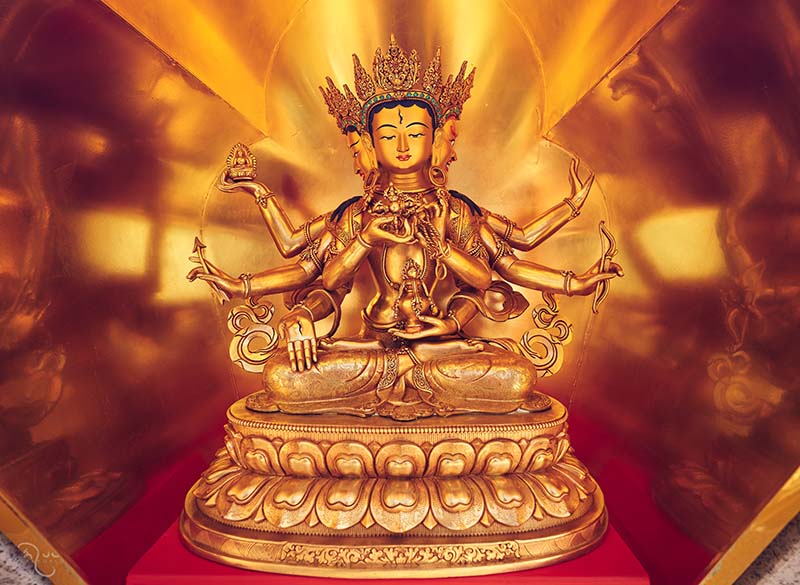Category: Buddhist Path | Love & Compassion Meditation | Recent Meditation Posts

Introduction to the Bodhisattva Vows of Buddhism
In Mahayana Buddhism, we take the bodhisattva vow when we become inspired by bodhicitta and feel compelled to dedicate our practice for the sake of all living beings.
Most of us would agree that all beings everywhere deserve to be happy and free of their pain. It is a nice thing to say. In practical terms, however, we may struggle with the question of whether all people deserve happiness, all the time, especially if they have hurt us or others.
But as we cultivate aspiring bodhicitta by meditating on interconnectedness, equanimity and compassion, there becomes no question. We cannot experience the greatest happiness but ignore everyone else. We cannot be free from hardship or suffering until we also wish that all others are also free.
To be motivated and commit our practice for the benefit of others, not just with lip-service but deeply in our hearts and in our bones, is to step into aspiration bodhicitta. It is then we should take the vow of a bodhisattva.
What are the bodhisattva vows?
In Buddhism, a vow is a promise, a commitment, a resolution that seals our intention. Vows are typically taken in front of a witness, a mentor or teacher whom we deeply revere and hope never to let down. If we don’t have a teacher, we can take the vow mentally or in front of an image of the Buddha until such time as a teacher appears in our life. The ritual of taking a vow strengthens the karma and merit of our intentions, words and actions.
Buddhist vows include the refuge vows, the 5 lay precept vows and the bodhisattva vows, in that order.
Refuge Vows: Having let go of the mistaken belief that samsara could ever offer us anything but disappointment, we renounce our ordinary way of indulging in self-centered confusion and take refuge in the three jewels.
Five Precepts: To maintain a clear mind in support of our practice, we commit to non-harming through the vows of the 5 precepts. As our practice continues, we also see that by being virtuous (keeping our karma clean) and practicing positive actions (building merit) we progress more quickly along the path.
Bodhisattva Vows: As wisdom and compassion deepen, it becomes clear that our freedom is not complete until we deeply commit that all others must also be free. The only way to enlightenment is to grab others by the hand and take them with us. With the bodhisattva vow we make this promise.
What do we promise with the bodhisattva vow?
To take a bodhisattva vow is to say, yes, I am prepared to take every action necessary to help others. It is a commitment to practice the six paramitas, or six perfections of giving and the rest. And, it is a commitment to keep the vows by refraining from the 18 root downfalls and the 46 secondary offenses. Committing to such practices and restraints is the best chance we have for reaching enlightenment for the sake of all beings, for whom we have taken responsibility.
For how long do we take the bodhisattva vow?
The five precepts can be taken for this life or for a shorter period. In the Theravada tradition, refuge vows are a commitment we make for this life only. In the Mahayana, we take refuge until attaining enlightenment, for all our future lives as well. The bodhisattva vows are also taken until achieving full enlightenment, and remain with us throughout our subsequent lives. Thus the vow is initially a seed, which can grow and strengthen by practicing the bodhisattva path. We take bodhisattva vows daily as an essential part of our practice, setting our motivation that all our practice and actions are focused on the benefit of all.
What breaks a bodhisattva vow?
To keep our vows, we must first understand the bodhisattva vow meaning. With these vows, we do not merely wish for the happiness of all others, but take responsibility for seeing to it that all beings indeed find happiness. We commit to exchanging places with others by putting them first, something which goes against our self-centered habits.
Vigilance, in the form of mindfulness and awareness, helps us keep our vows. We are not only vigilant in thinking about others, but take great care not to transgress the 18 root downfalls and 46 secondary offenses. To commit a root downfall, such as abandoning the wish to benefit beings, is to lose our bodhisattva vows. It is to take a step backwards on our spiritual path.
If we do break a root downfall and lose our vows, we can still repair them. We can purify the transgression with confession and meditation on kindness and compassion, retake our vows and begin anew. Thus, the perceived enormity of the great bodhisattva vows should not prevent us from walking the bodhisattva path. We cannot be perfect from the beginning. Becoming a bodhisattva is something we all have the innate capacity to do. The inspiration of the bodhisattva vow has a powerful transformative affect on our lives, and therefore to everyone around us.

